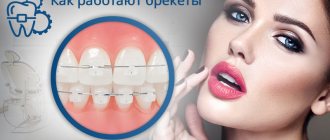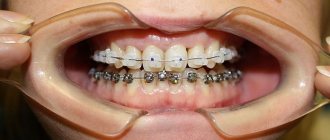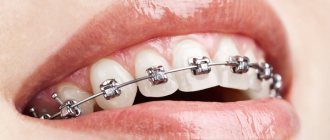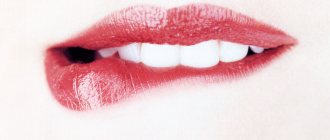Reading time 7-8 minutes
Author of the article: Tsurkan Victoria Olegovna
Specialization: Dentist-orthodontist
Total work experience: since 2015
- Stages of defect correction and expected results
- How long should you wear traction braces?
- Brief summary
When deciding on the use of orthodontic structures, patients are often interested in how long they wear braces on their teeth. Since the timing is determined individually, it is important to answer the question of what affects the duration of wear and what results to expect during the treatment process and after its completion.
People around you start to envy you kindly
Not many people can boast of a perfect smile, but only a few take on this problem. However, braces on an adult are causing others to think about going to the dentist again. Yes, people around you will pay attention to you more often; friends and acquaintances will begin to be interested in the details of the treatment, the sensations, and the cost of the design. One thing is for sure - they will respect you, because you care about your health and did what many do not dare to do. In addition, not everyone is ready to shell out more than 100 thousand rubles to correct their smile.
What do the doctor's say?
Orthodontists say that the age from 15 to 20 years is the most favorable for straightening teeth and correcting bite. It is during this period that the jaw tissue is most “pliable”; the process of orthodontic treatment is completed successfully in almost all cases.
If you take up this issue at an older age, the tactics for correcting the bite have significant differences:
- The duration of therapy is at least three years.
- To begin aligning the units, you may first need to remove any teeth in the mouth that may prevent the teeth from moving into the correct position.
- If the condition was deplorable before treatment, the specialist may recommend wearing retainers for life. They are completely invisible in the mouth, so many patients do not see this as a problem.
In general, experts do not see anything wrong with starting to correct the bite after 35 years. If you do nothing, this is fraught with the following complications:
- In the future, teeth will begin to decay much earlier than expected.
- Increased wear of the enamel may occur.
- The risk of dental diseases increases, ranging from caries to periodontitis or periodontal disease.
- The face becomes asymmetrical.
- Incorrect bite also affects diction.
Reaching a new goal
Perhaps you are faced with a difficult choice: on the one hand, you are embarrassed about your smile, on the other, you do not want to wear braces for 1 to 3 years. But the faster you start, the faster you finish. As they say, the best time to do this is yesterday, the second best time is today. Moreover, you will experience great joy as you systematically move towards your goal, seeing how your teeth are straightened month after month, and in the end you will get the long-awaited result - a beautiful smile. This experience will certainly be useful in other areas of life.
Braces or aligners? No, veneers!
After conducting digital diagnostics, I eventually told her that it was theoretically possible to install veneers while maintaining a normal bite. Everything can be done provided that your joint does not hurt, nothing crunches, everything is comfortable for you and absolutely nothing bothers you.
And we decided to try to make her a digital project, in which we will see if we can install veneers with such crooked teeth. That is, can we do the work on the veneers, place them evenly enough so that she likes it?
Also in the project you can see some footage where the doctor understood how much the lower teeth needed to be ground down in order to get an even lower dentition, that is, how much each tooth needed to be ground down minimally in order to get an even dentition.
Why was it necessary to sharpen the teeth as little as possible?
So as not to reach the nerve. Because when we carried out the work, we almost reached the nerve, but even in such a serious crooked situation with the teeth (they were looking in different directions), we did not depulpate a single tooth and received an absolutely even dentition.
We made casts and a photographic protocol. I initially saw that the teeth were as crooked as possible, but I always knew that no matter what “crooked” situation we found ourselves in, everything always turned out smooth. In Maria’s situation, my experience told me that it would turn out quite smoothly and nothing should bother her, taking into account the fact that we will be covering 20 teeth with veneers - 10 on top
and
10 from below
.
What are braces and who are they for?
We have known about braces for quite a long time - both in life and in movies we have seen people with characteristic braces on their teeth. Essentially, braces consist of small clasps glued to the teeth with special dental glue, and a metal arch passing through them, connecting them into a single system.
The archwire transfers pressure to the teeth, which causes the misaligned teeth to gradually shift toward a more correct position. As the defects are corrected, the arch must be tightened: for this, the patient needs to visit the dentist once every 2 weeks, and after treatment is completed, he also needs to wear special retainers that will prevent the possibility of reverse displacement of the straightened teeth.
At the same time, there is another method - the use of aligners. What is the difference between braces and aligners? Aligners are transparent aligners made of special plastic that fit tightly onto the teeth and create the necessary pressure to correct misaligned teeth. Speaking about the difference between braces and aligners, it can be noted that braces create many inconveniences in everyday life: they are clearly visible from the outside, they must be thoroughly cleaned after every meal, they are difficult to get used to and serious dietary restrictions must be observed during the period. wearing them.
However, in case of serious malocclusion, it is necessary to wear braces. In addition, aligners are usually used only for adults who have completed their period of jaw growth, although aligners are now being developed for children over 7 years of age. Braces do not have such a limitation - they can be placed on children at almost any age.
In addition, there is a difference between braces and aligners in the force of impact: braces are a more rigid structure that puts more pressure on the teeth, so they can be used to correct more complex situations.
Does it hurt to remove braces: the penultimate stage of treatment
The last step in correcting the bite with braces is to install a retainer - a thin wire to fix the corrected teeth in the optimal position. But this period is preceded by the removal of the braces from the teeth.
The procedure for removing braces follows the following scheme:
- Removing ligatures with tweezers - if these fasteners are present in the system.
- Removing the arc.
- Detachment of plates from tooth enamel is done with a special dental instrument.
- Hygienic treatment of the tooth crown - removing residual glue or composite cement, grinding the enamel.
- Strengthening with fluoride – to guarantee the safety and health of teeth.
Patients experience the removal of braces differently. Some people feel nothing, others are dissatisfied with the vibration during grinding, while others report mild pain.
The last one, the retention period, is the most comfortable. A thin wire is attached to the inside of the teeth - it is invisible and does not affect the quality of life in any way.
Dolotova Marina
“Only one of my patients found it painful to remove braces. The rest calmly tolerated the procedure - removing the plates and excess glue. Pain during removal is very rare.”
How do braces work?
Naturally, the doctor works with each patient individually. There are many types of braces, as well as many types of malocclusions. Already during the consultation, it becomes clear what problem is relevant and how to solve it.
How do braces work? After choosing a design, the doctor will carefully place the lock in the desired position on each tooth. Here it is important to take into account not only the position of individual teeth, but also the condition of the entire row. After all, even a small change in the position of one element leads to a displacement of all the others. Therefore, it is extremely important to configure everything correctly.
During treatment, the patient must regularly visit the doctor for preventive and corrective examinations. As the correction progresses, the doctor will gradually move the braces, adapting them to the new position of the teeth.
How long should you wear braces?
Another common fear of patients is always the duration of treatment. Despite all the promises of doctors and the testimony of other patients that the installation of the structure has practically no effect on the usual rhythm of life, it is always difficult to decide to correct teeth. It seems like I'll have to wear braces forever!
How long do you really need to wear braces? We have already said that in childhood, treatment is faster due to the characteristics of bone tissue, which is still pliable and ready for rapid changes. Therefore, for children, the period of wearing structures is about 6–12 months, and in complex cases or adolescence it can increase to 1.5 years.
For people 20–30 years and older, the average treatment period is 2 years. The teeth are already firmly fixed in their position, and it will be more difficult to move them from their place.
Don't forget that in dentistry everything is very individual. Your case may be exceptional and require unusual deadlines. It is also possible that the bite will correct itself faster than expected. For example, if self-ligating braces are used. The main thing is not to forget to visit the doctor strictly in accordance with his recommendations, so as not to miss the opportunity to shorten the treatment period.
Teeth don't move
Initially, incorrectly planned orthodontic treatment with braces sometimes leads to a dead end. The bracket system is exhausting its resource. The arcs take an even position and also stop working. However, the teeth are in an uneven position that does not suit the patient and the doctor. Additional efforts do not lead to the desired result. Natural questions arise for the attending physician. Mutual claims and excuses. In general, an unpleasant situation. This is due to initially incorrectly planned orthodontic treatment. Inaccurate calculation. Ignoring the fundamental rules of the protocol for fixing the bracket system and diagnostics before starting to correct the bite with braces. Perhaps the inexperience of the attending physician, or the so-called human factor. Recently I was contacted by a patient who has been undergoing treatment with braces for about 10 years! Sometimes it happens. There is no need to panic and ring the bells. Almost any movement of teeth in the mouth is reversible as long as the teeth have strong roots, and the orthodontist understands the essence of the treatment and knows what he is doing. There are many ways to correct the situation. For example, bending an arc. The orthodontist, understanding the essence of the problem, bends the arch, thereby forcing the arch to work in the desired direction.
In the arsenal of a professional orthodontist there are many methods, devices and devices for moving teeth, but despite all this, there are reasons and situations in which the braces system cannot help. Ankylosis of the tooth. One of the most common dental anomalies. For one reason or another, the tooth loses its periodontal ligaments, which make movement possible. The tooth is firmly fused with the bone and its movement becomes impossible. Such a tooth, as a rule, is underdeveloped and has a smaller height in relation to the dentition. Often has a different inclination in the dentition. When tapped, it makes a muffled sound. An ankylosed tooth requires therapeutic and orthopedic intervention to return it to bite. As an option, creating an artificial crown. It is possible to camouflage the tooth with veneers, lumineers or aesthetic restoration, according to indications.
And in conclusion, let me once again remind you of the importance and necessity of preliminary diagnosis, analysis of OPTG or CBCT images, casts and, if necessary, more complex studies before correcting the bite with braces. Competent and accurate diagnosis is the key to the success of orthodontic treatment. Take your time when starting orthodontic treatment, weigh everything and find out more information. Get advice, get advice and be healthy!
TOP 5 fears of patients
Let's look at the main fears that make patients doubt whether to put braces on their jaw. Some of them are partly justified, some are not.
- For a long time. Yes, correcting a bite is not quick; treatment in adulthood takes an average of 1.5-2 years. But the result is worth it! Already in the first few months you will notice positive changes that will brighten up the period of wearing braces. Be a little patient, soon your dream of a beautiful smile will become a reality, and the question of whether you need to get braces will no longer be relevant!
- Noticeable. Most often, this question is relevant for girls and worries more than painful sensations when wearing. For patients who are concerned about the aesthetics of their smile, less noticeable systems have been developed - ceramic and sapphire braces, which are not so noticeable compared to standard metal ones. There are also invisible lingual braces that are attached to the back of the teeth, so the visual component is not a problem.
- Hurt. Unpleasant sensations while wearing braces are possible, but they are typical only for certain periods. Firstly, installing braces and getting used to them for the first 1-2 weeks. Secondly, correction of braces, which will be performed by an orthodontist approximately every 4-8 weeks. During the rest of the period after getting used to it, the structures will be almost not felt.
- Difficult to care for. During the period of wearing orthodontic systems, you will need to give up certain foods and drinks, and also pay special attention to oral hygiene. Yes, this is more labor-intensive than simply brushing your teeth, but patients quickly get used to this process, and it no longer causes as much discomfort as it might seem at the first stage.
- There will be no result. If you choose a competent orthodontist and follow all his recommendations, you will definitely get a beautiful, even smile as a result. Yes, this path requires time and effort, but it is better to decide and do it than to spend your whole life thinking about how to correct crooked teeth.
Types of bracket systems
Orthodontic systems are divided into external (vestibular) and internal (lingual).
— External braces are the most common option. The most popular systems are metal, ceramic, sapphire. Metal braces are characterized by the lowest price, but they are most noticeable on the teeth. Ceramic and sapphire ones are not so striking, but their cost is higher.
— Lingual braces are structures that are installed on the back wall of the teeth and are completely invisible when smiling. Because of this, the system is often of interest, but this option has a number of disadvantages: difficult care, possible injuries to the tongue and mucous membranes, extended wearing time, and the highest price.
Contraindications
For Patients over thirty years of age, braces cannot always be placed; there are a number of absolute contraindications:
- malignant neoplasms;
- diabetes of any type;
- problems with immunity, HIV;
- mental disorders, nervous system;
- periodontal disease;
- pathology of bone tissue;
- edentia, in which a large number of teeth are missing;
- blood diseases, poor clotting;
- tuberculosis.
Relative contraindications that must be eliminated before installing the structure include:
- arthritis affecting the TMJ;
- hormonal disorders;
- poor oral hygiene;
- presence of prostheses or implants;
- endocarditis and others.
Before starting therapy, the doctor must conduct a diagnosis. This allows you to identify contraindications, obtain data for choosing a device and drawing up a correction scheme.
Does it hurt to get braces? Let's figure it out!
Does it hurt to put braces on children 13 years old? Is installing a system painful at 14 years old? Does it make a difference when to see a doctor? In fact, the installation algorithm does not depend on age, and always includes the following orthodontic manipulations:
- Cleaning the teeth with a special paste and covering the crown with a composition that increases enamel adhesion.
- Fixation of rings or locks on the distant chewing teeth, which are responsible for fastening the end parts of the arch.
- Gluing plates - correcting the position of the element and removing glue residues.
- Installation of a metal corrective arch into the grooves of the braces.
- Fastening the arch - with ligatures or using snap clasps.
The work is painstaking, requiring a thorough approach on the part of the dentist, but completely painless for the patient. The only discomfort at this stage is the need to keep your mouth open. The installation of a brace system on one jaw takes about an hour, so the orthodontist usually prescribes two appointments so as not to tire the patient and make it easier for him to adapt to the device.
Plaksina Margarita
“I install braces in two steps, with the interval between meetings reaching 3-6 months. This approach has great advantages: the child does not need to sit in a chair with his mouth open for 2-3 hours - that’s it. Accelerated adaptation to braces, reduction of discomfort during the adaptation period – two and three.”











